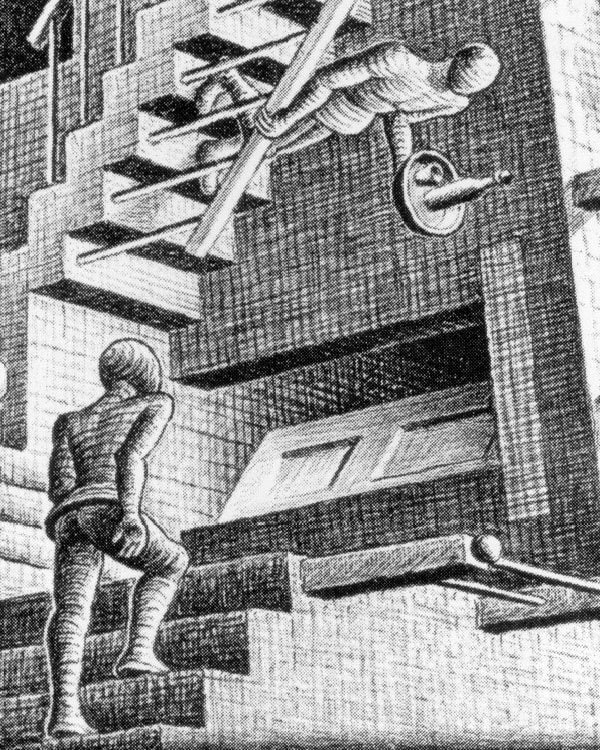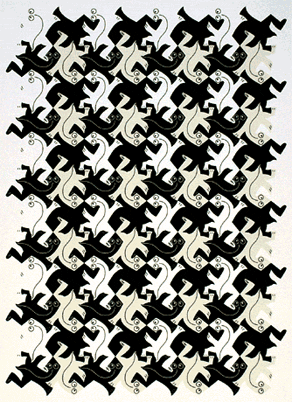Surprising Facts About Mc Escher Art Relativity M C Escher

Section of Relativity by Grand.C. Escher
Biography
Thousand.C. Escher, or Maurits Cornelis Escher, built-in on June 17, 1898, in Leeuwarden, Netherlands, was a graphic creative person known for his creative, and mind boggling drawings, woodcuts, lithographs, and mezzotints. His most famous works are his incommunicable structures, tessellations and his explorations of infinity. At a young age, Escher did poorly at school, even during his enrollment at the School of Compages and Decorative Arts in Haarlem, Netherlands. At that schoolhouse, he offset studied compages but failed in many of the subjects. He and so switched to the decorative arts where he studied under Samuel Jessurun de Mesquita. Information technology was and so that Escher gained feel in cartoon and making woodcuts. Escher traveled constantly, moving back and forth from the Netherlands to Italy, Belgium, and Spain. It was during these travels that Escher produced well-nigh of his works. Escher says that his stay in the Alhambra castle in Espana was "...the richest source of inspiration I take e'er tapped." Escher connected to travel until he finally moved to a retirement home for artists in 1970. Only two years afterward that, Thou.C. Escher died on March 27, 1972 at 73 years old.

Geckos past M.C. Escher
Drawing Easily is a lithograph of two hands both drawing each other on a piece of newspaper. The hands themselves await very realistic, photo-like. The composition, placement, of the hands forms a big circle, which I think, once more, is contributing to Escher'southward fascination with infinity. It is somewhat creepy the way the easily are, at one point, led on a newspaper, and then the side by side moment they accept popped out of the newspaper and are real easily. I like this piece because it is simple, unlike most of Escher'southward works. I'thou sure this piece would be difficult to indistinguishable, it's not uncomplicated in that way, but I recall it is elementary considering it is easy to view. I think Cartoon Hands could as well be another manner Escher has portrayed "cocky-reference." This ane is more straightforward because the hands are literally creating each other, just like we create ourselves.
M.C. Escher produced his works during the era of Modernism—the era of "reinventing" fine art. However, Escher did non prescribe to whatsoever "ism" at all. He merely created whatever he wanted to. He had an farthermost interest in certain aspects of life, such equally tessellations (repeating tiles), polyhedron (3-dimensional geometric objects), the shape and logic of infinite (the relationship betwixt concrete objects), and infinity (including the möbius strip and tessellations). These are the subjects of many of Escher's works. Though Escher did not have whatsoever formal training or education in mathematics, nigh all of his works use complicated mathematical principals. Escher'southward work fits into the Modernist era because he produced his art merely because he could, and because he wanted to. His bailiwick affair would never have been accepted in the Middle Ages or the Renaissance, but in the Modern Era, such paradigms were not considered anymore.
I noticed that Chiliad.C. Escher produced a lot of his work during Earth War II. In fact, one time he had to move out of Kingdom of belgium back into holland considering of the war. I noted that different many artists who tailor their works around the social happenings at the time, Escher's piece of work doesn't change at all. He continues to create the same things without any social commentary on the surrounding war.
Although Escher did non invent tessellations, he did however basically perfect them. He is prominently known for creating tessellation masterpieces. Even today, tessellations are used in flooring tiles, counter tiles, and wallpaper. I can merely imagine that Escher's work helped perpetuate the use of tessellations because he fabricated them famous and interesting.
My favorite function about G.C. Escher's work is that he plays with the viewer's noesis of reality and perception. Most of his drawings are optical illusions because they seem to be impossible, merely, at the same time, he draws them then well that they await real. I was amazed to run into his work because it opened my eyes to the way pictures can trick the mind. Escher's creation called Waterfall is a perfect example of the way he tricks the viewer's mind. In the cartoon, water is pushed along an aqueduct past a waterwheel until it reaches the end of the aqueduct where it falls back down to the showtime where it turns the waterwheel, again pushing the water along the channel. This is a paradox considering the water appears to be traveling downhill, and by the laws of physics it should, merely it ends upward at the top of the structure somehow, where it falls back downwards to the bottom. I call up Escher is messing with the brain'south insistence to view two-dimensional objects every bit three-dimensional objects. By 2-dimensional terms, this drawing makes perfect sense, simply when yous view it past three-dimensional terms the brain unhinges considering the object represented in the flick is physically impossible to create. I am impressed because it is a very ingenious idea, and because it is very detailed, using ii point perspective and shading to create realistic three-dimensional objects. Not only that, but I think the most fun part is to just await at it and to attempt to figure out how he does it.

Relativity by M.C. Escher
Relativity
My favorite piece of Escher'south work is called Relativity, which depicts a world where people are living amidst each other but on different planes of existence. There might be a stairway with one person walking up the stairs, yet underneath those same stairs, upside-downwardly, another person is walking downwards them. The picture is full of these casuistic situations. I am personally interested in portraying three-dimensions on a two-dimension surface, so Relativity is peculiarly interesting to me because Escher does a fantastic job of creating iii-dimensional worlds all wrapped upward in each other. Too being a stunning display of creative skill, Relativity has meaning on a deeper level. To me, I see the faceless, identical people living among each other but acting as though they are oblivious to others effectually them. This seems to be a representation of our lives. We are frequently so consumed with our own lives, only caring about ourselves, that we ignore those around the states. It is a selfish way of life, and I call back that Relativity is an analogy of this fact in a truly unique way.

by G.C. Escher
Self-Reference
Subsequently researching information nearly Escher'southward work, I began to observe a reoccurring theme in his work. Although very subtle, Escher ofttimes created things which represented the idea of "self-reference". We are ourselves because nosotros've fabricated ourselves the way we are. It is a never ending cycle—hither again is an exploration of infinity, although more abstract. In Escher's work, Three Spheres II, there are three drinking glass spheres sitting on a flat surface. On the surface of one sphere is a reflection of a room. On some other sphere, the artist himself is reflected in its surface. On the last sphere, the paper on which the artist is working is reflected. Although each sphere represents something else, they are all connected with each other. The second sphere is extremely significant because it reflects the creative person himself. It is a self-portrait, a cocky-reference, a reflection of the artist, the artist beingness reflected in his work.

Drawing Hands by M.C. Escher
Decision
Overall, K.C. Escher'southward work has a systematic, mathematical tone to it, which interests me. Math and science are interesting and fascinating subjects, then when I come across the mathematical genius backside Escher's work, I am that much more excited by information technology. Also, 3-dimensional design is my favorite type of fine art. A lot of M.C. Escher's piece of work deals with three-dimensional blueprint. Just from researching his piece of work, I found out a lot of information almost perspectives. Beforehand, I had just thought there was i and two point perspective. But afterward researching Ascending-Descending, I learned that at that place are really iii point and iv betoken perspectives, all the way up to six point perspective.
Scroll to Continue
Read More From Owlcation
Chiliad.C. Escher produced a lot of works using complicated processes such as lithography, woodcutting, and mezzotints, which even subsequently hours of research, I still don't fully sympathise. Not only was he considered a master of these printmaking styles, but he was also a chief of mathematics. Scholars today are notwithstanding having trouble trying to effigy out how Escher designed and produced some of his work. The fact that Escher did this shows how significant his work is. When he produced his work, long agone, he was actually way alee of his time. What is fifty-fifty amend is that he had no in-depth math education, it was all intuitive. To exist able to self-teach yourself that kind of complicated math would exist near incommunicable, yet, Escher does it every bit though information technology were as like shooting fish in a barrel as breathing. Finally, what stands out to me the almost, afterward having learned more than well-nigh M.C. Escher's personal life, is that he did poorly in schoolhouse. He was below, beneath average in many courses. This opened my eyes because I often feel that to be successful you have to get "A'south" in every class. Escher failed many of his classes, but his artwork is famous and will always be famous. You do not need to be the superlative of your class to make an impact in the globe, contrary to today'south pop belief. M.C. Escher is i of a kind because not only is he insanely imaginative, but he is very skilled at manipulating the sense of sight.
References
Bart, Anneke, and Bryan Clair. EscherMath. 2007. 20 April. 2008
<http://euler.slu.edu/escher/index.php/M.C._Escher>.
Locher, J L. M.C. Escher: His Life and Complete Graphic Work. Amsterdam: n.p., 1981.
1000.C. Escher Visitor. The Official M.C. Escher Website. 21 Apr. 2008 <http://www.mcescher.com/>.
Platonic Realms. "Mathematical Fine art of G.C. Escher." Platonic Realms. 2008. 20 April. 2008 <http://www.mathacademy.com/pr/minitext/escher/index.asp>.
janie dillman on May ten, 2019:
exercise you guys know how he used math in these art pieces?
fakeman on November 02, 2018:
this stuff is simulated
z on April 04, 2017:
i need his nigh famous artwork/what he is most famous for
Herrexius on February 21, 2015:
Very well explained. Brilliant work; Good wishes.
Cake on February 20, 2015:
Absurd
andersonyoulgessaid.blogspot.com
Source: https://owlcation.com/humanities/The-Artwork-of-MC-Escher
0 Response to "Surprising Facts About Mc Escher Art Relativity M C Escher"
Post a Comment